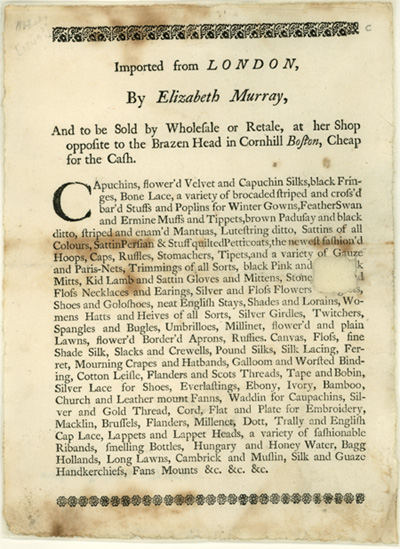
|
|
Elizabeth Murray Broadside [c.1750] Printed to order on one side of a large sheet of paper, broadsides were used for a variety of purposes, including announcing sales, presenting political views, and selling new song lyrics. Elizabeth Murray's broadside, printed around 1750, served several important functions for her new business. A newcomer, she had to introduce herself and her business. Listing a lengthy variety of goods, Elizabeth Murray let literate consumers know what wares they might find in her shop just by the Town House. Her location, in Cornhill, was a central one, near some of the most important economic and cultural structures in the small, walkable town. Over the course of the next ten years, she advertised repeatedly in newspapers, as did a small percentage of other women shopkeepers. From the 1720s on, newspapers carried increasing numbers of advertisements, which took up much of the space in each issue. Both the quantities and varieties goods increased dramatically over the next few decades. For Murray's business career, see Patricia Cleary, Elizabeth Murray: A Woman's Pursuit of Independence in Eighteenth-century America, Amherst: University of Massachusetts Press, 2000. On eighteenth-century consumer culture, see T.H. Breen, The Marketplace of Revolution: How Consumer Politics Shaped American Independence, New York: Oxford University Press, 2004, and Richard Bushman, The Refinement of America: Persons, Houses, Cities, New York: Knopf, 1992. |
||
For other examples of colonial advertising, see Trade Cards, Broadsides and Advertisements in Browse the Collection portion of our site. |
|||
 Trade bill, advertising broadside of Elizabeth Murray, [c.1750]. Massachusetts Historical Society, Boston
Trade bill, advertising broadside of Elizabeth Murray, [c.1750]. Massachusetts Historical Society, Boston

